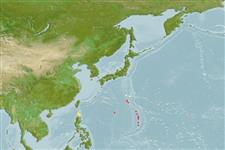>
Acanthuriformes (Surgeonfishes) >
Pomacanthidae (Angelfishes)
Etymology: Centropyge: Greek, kentron = sting + Greek, pyge = tail (Ref. 45335).
Eponymy: John W Shepard worked at the Marine Laboratory, UOG Station, Mangilao, Guam (part of the University of Guam). [...] (Ref. 128868), visit book page.
More on authors: Randall & Yasuda.
Environment: milieu / climate zone / depth range / distribution range
Ecologie
marien rifbewoner; standvastig; diepte 1 - 56 m (Ref. 1602). Tropical; 28°N - 15°N
Western Pacific: known only from the Mariana and Ogasawara Islands; possibly a population southwest of Palau.
Grootte / Gewicht / Leeftijd
Maturity: Lm ? range ? - ? cm
Max length : 9.0 cm TL mannelijk / geslacht onbekend; (Ref. 9710); common length : 7.0 cm SL mannelijk / geslacht onbekend; (Ref. 37816)
Dorsale stekels (totaal) : 14; Dorsale zachte stralen (totaal) : 16 - 18; Anale stekels: 3; Anale zachte stralen: 17 - 18. Its ground color is variable, ranging from almost red to light apricot. The barring can be reduced to a small patch behind the operculum, and in rare cases, be entirely absent. The blue trim on the soft dorsal and anal fins is absent or reduced in females and highly developed in males.
A common species (Ref. 9710) found singly or in small groups in exposed outer reef slopes and occasionally in clear lagoon reefs. Prefers areas of mixed dead and living corals with numerous shelter holes and passages (Ref. 1602). Feeds mainly on benthic algae. Forms harems of 3-7 individuals. Occasionally exported through the aquarium trade (Ref. 48391).
Levenscyclus en paargedrag
Maturiteit | Voortplanting | Paaien | Eieren | Fecunditeit | Larven
Allen, G.R., 1985. Butterfly and angelfishes of the world. Vol. 2. 3rd edit. in English. Mergus Publishers, Melle, Germany. (Ref. 4858)
Status op de Rode Lijst van het IUCN (Ref. 130435: Version 2024-2)
Gevaar voor de mens
Harmless
Gebruik door de mens
Visserij: commercieel; Aquarium: Commercieel
Tools
Speciale rapporten
Download XML
Internetbronnen
Estimates based on models
Fylogenetische diversiteitsindex (Ref.
82804): PD
50 = 0.5000 [Uniqueness, from 0.5 = low to 2.0 = high].
Bayesian length-weight: a=0.03090 (0.01378 - 0.06932), b=2.88 (2.69 - 3.07), in cm total length, based on LWR estimates for this (Sub)family-body shape (Ref.
93245).
Trofisch niveau (Ref.
69278): 2.0 ±0.00 se; based on food items.
Weerstandsvermogen (Ref.
120179): Hoog, minimale populatieverdubbelingstijd minder dan 15 maanden (Preliminary K or Fecundity.).
Fishing Vulnerability (Ref.
59153): Low vulnerability (10 of 100).
Nutrients (Ref.
124155): Calcium = 122 [56, 193] mg/100g; Iron = 0.789 [0.466, 1.392] mg/100g; Protein = 17.8 [16.5, 19.0] %; Omega3 = 0.115 [0.066, 0.194] g/100g; Selenium = 27 [13, 55] μg/100g; VitaminA = 93.3 [21.0, 385.4] μg/100g; Zinc = 2.13 [1.41, 3.26] mg/100g (wet weight);
